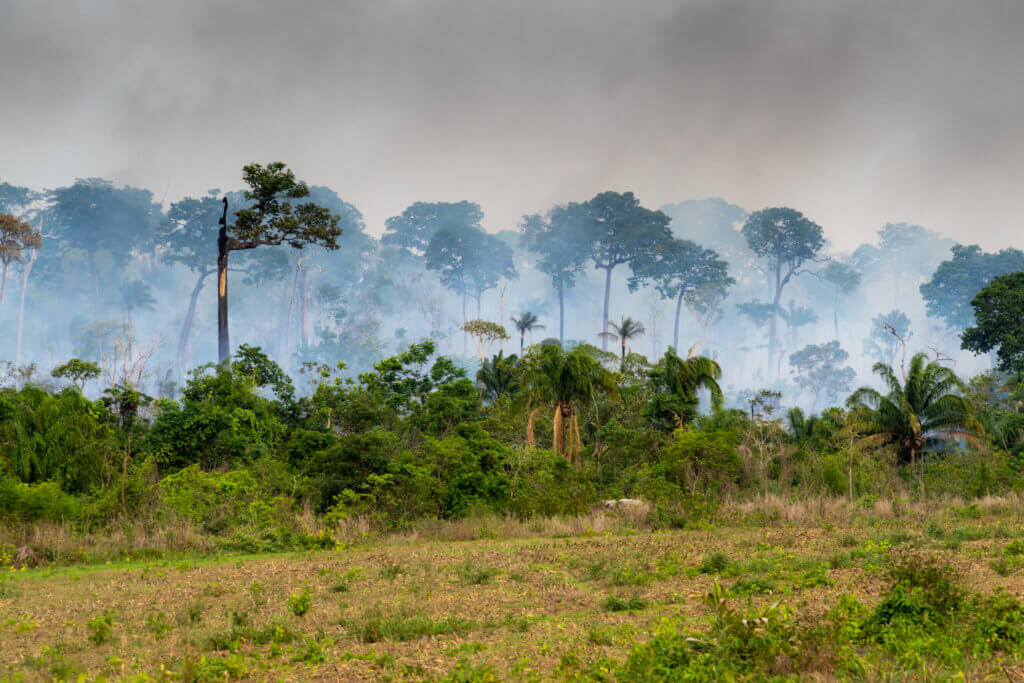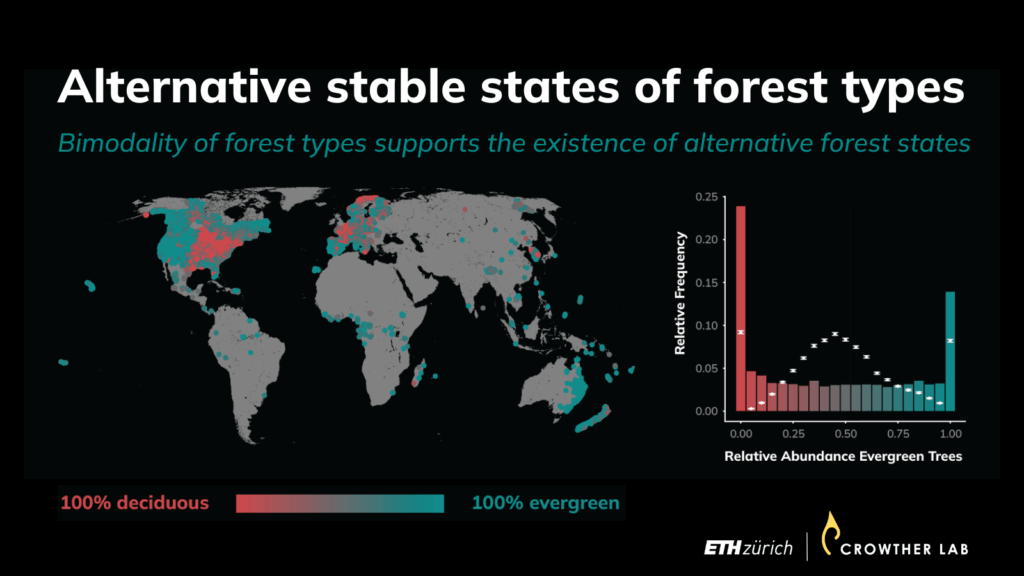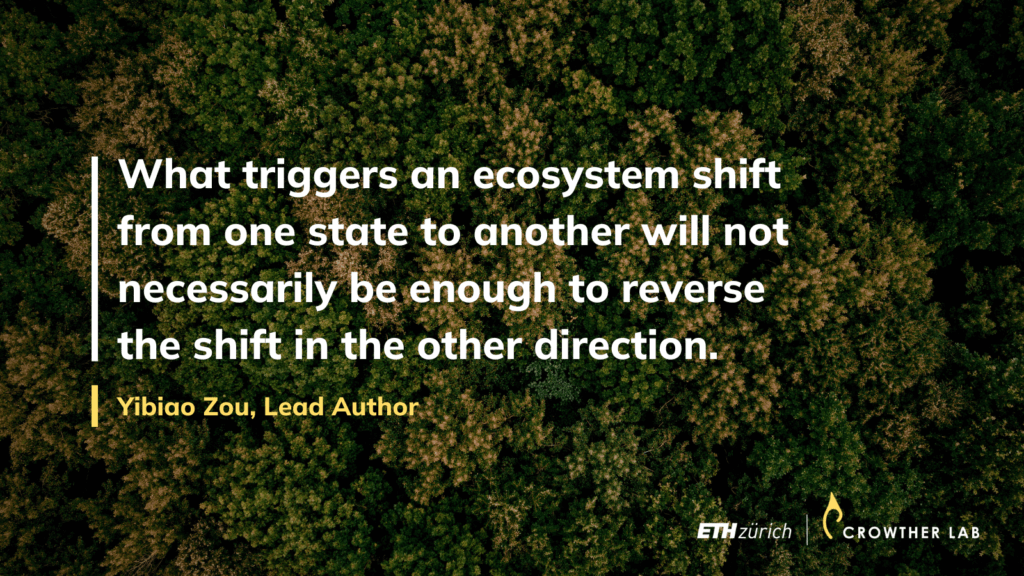A Q&A with Yibiao Zou, PhD student and lead author of “Positive feedbacks and alternative stable states in forest leaf types“
Recent research indicates that the Amazon rainforest is losing its resilience. Ecologically, this suggests it may not be able to remain a rainforest, with forested areas potentially turning into savannas over time. What we’re witnessing here is an ecosystem approaching a tipping point. In the tropics, forests and savannas are known to be two sides of the same coin, two so-called alternative stable states. What does that mean? Let’s break it down: stable means that there are feedbacks and processes in the ecosystem helping them to maintain their state. Alternative means that they can switch – in response to certain triggers – from one state to the other, such as from forest to savanna, or from savanna to forest. In our example a trigger might be an increase in droughts or wildfires.
Ecological alternative stable states, however, are not confined to the tropics; they exist globally, though not all are as extensively studied as tropical forests and savannas. PhD student Yibiao Zou has just published his study on alternative stable states in temperate forests (or alternative forest states). In this interview he explains why we need to study them, what evidence he found, and what it reveals about the future of temperate forests.

In the tropics, increased wildfires are known to potentially trigger ecosystem shifts from forest to savanna.
Why do we need to study alternative stable states?
Yibiao Zou: Major disruptive events like natural disasters or excessive human activity, or gradual changes in environmental conditions such as global warming, can trigger ecosystems to change into a new, different state, transforming them from one stable state to an alternative stable state.
Studying alternative stable states can not only further our understanding of different ecosystems and how they function, but also tell us how resilient an ecosystem is, and at which critical points small changes lead to major, disruptive shifts. With enough data, we can predict the potential for ecosystem shifts, develop better conservation and resource management strategies, and avoid or reduce negative impacts on ecosystems. In summary, understanding alternative stable states helps us to keep our ecosystems healthy and functioning, which is essential for the well-being of all species, including humans.
Why did you want to study whether alternative forest states exist in temperate regions?
Yibiao Zou: Alternative stable states are quite well researched for the tropics; we know relatively much about the shift from forest to savanna and vice versa. However, alternative stable states can not only be found in the tropics, and can occur for different forest types.
Previous theoretical studies have suggested that evergreen and deciduous forests in temperate areas may be alternative stable states. Unlike in the tropics, where evergreen forests dominate (one stable state), the environmental conditions in temperate regions allow both evergreen and deciduous forests to establish, which provides the basis for alternative forest states to emerge. However, we always lacked large-scale empirical evidence for this theory, and so I wanted to close that knowledge gap.
In our paper, we analysed a massive dataset of ground-sourced observations and performed data-driven simulations to test for the existence of alternative stable states in forest types.

The clear bimodal distribution of deciduous and evergreen forests in temperate regions is a critical indicator of existing alternative stable states.
Do alternative stable states exist for temperate forests? What evidence did you find?
Yibiao Zou: Our analysis of global forest data reveals a clear bimodal distribution of evergreen and deciduous forests. This means that the majority of temperate forests are either evergreen or deciduous, yet rarely mixed; a strong sign of two alternative states within forest ecosystems.
But are they also stable? Our data provides first-time continental and global evidence that there are positive feedback loops maintaining these systems, meaning that there are processes in each system that work in favour of trees of the same type. In a deciduous forest for example, deciduous trees would have a much better chance to survive or to grow than evergreen trees. The same would vice versa be true for evergreen trees in an evergreen forest.
Our data-driven simulations then confirmed: the processes we identified as positive feedbacks are necessary and sufficient to generate alternative stable states. Without them, there would be no bimodal distribution of evergreen and deciduous forests in temperate regions like we currently have on Earth.
Were there any challenges in finding this evidence?
Yibiao Zou: A big challenge was the lack of long-term data on forest changes. Ecosystem shifts don’t happen overnight – there is a threshold that needs to be crossed where small changes add up to a major shift. This lack of long-term data means we can never actually observe such transitions and need to rely on simulations and models.
What’s more, we had to analyse an extremely large amount of data – more than one million forest plots of each over 30 million individual trees – with different approaches. I benefited a lot from my colleagues’ help, the coding skills I learned from my ETH courses, and the use of high-performance computing.
Why does it matter to know that temperate forests exist as alternative stable states?
Yibiao Zou: Knowing that temperate forests can exist in alternative stable states provides critical information for managing and conserving forest ecosystems. Our study allowed us to map these ecosystem types and identify where alternative forest states are especially prevalent (hotspots). Future research could combine this information with data about past events and environmental conditions, and gain key insight into how they influence present and past forest types in different locations and which long-term changes lead to shifts between forest types. These shifts matter because deciduous and evergreen forests work in different ways: for example, they sequester carbon at different rates and vary in carbon stock potential. Shifts from one ecosystem state to another therefore can have significant consequences.
Another characteristic of alternative stable states is called “hysteresis”. It describes simply that it’s not that easy to go back: what triggers a shift from one state to another will not necessarily be enough to reverse the shift in the other direction. For example, if warmer annual mean temperatures would turn an evergreen into a deciduous forest, a temperature drop would not necessarily restore the former evergreen forest. This highlights once more how important it is to be aware of ecosystem dynamics.
How do these findings matter in the context of climate change?
Yibiao Zou: Climate change is expected to impact the frequency and intensity of changes in forest ecosystems. Changes in temperature or precipitation patterns and an increase in extreme weather events can disrupt the existing balance, and push forests towards one stable state or another. For example, prolonged droughts or heat waves might make it harder for certain forest types to regenerate and maintain their current state. This could also potentially lead more often to shifts between stable states.
Research is still underway, so we cannot definitively say that there is any trend towards one state becoming more common than the other. However, it is plausible that as climate conditions change, certain forest types might be favoured in certain regions and thus more prevalent. For instance, it is very likely that future temperatures will be warmer in boreal regions, so coniferous evergreen forests adapted to the cold might, in this region, be replaced by broadleaf-deciduous forests that are more adapted to warmth.
In summary, while we know that climate change will impact forest ecosystems and potentially influence their stable states, more research is needed to predict specific trends and outcomes. Understanding these dynamics is crucial for effective forest management and conservation strategies in a changing climate.

